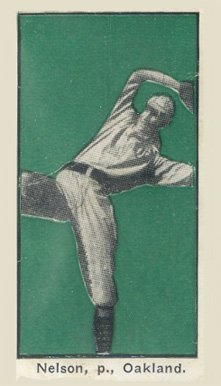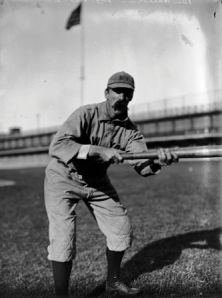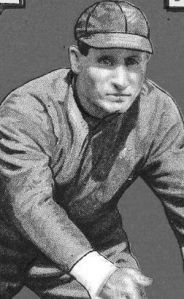Michael Angelo “Mique” Fisher is one of the forgotten pioneers of the Pacific Coast League (PCL). Fisher had no given middle name, but adopted the name Angelo “after the famed painter he admired.”
Born in New York City in 1862, Fisher’s family relocated to Sacramento, California shortly after the end of the Civil War. Fisher was a semi-pro outfielder with teams in San Francisco, Oakland and Sacramento, and in 1884-85 played for the San Francisco Haverlys in the California League. Sometime later in the decade he joined the Sacramento police force.
Fisher’s only connection with baseball from 1885 until he was nearly 40-tears-old was as a fan and as a friend of a young catcher named Charlie Graham who had played at Santa Clara University and in the California League.
In 1902 Detective Captain Fisher made a career change.
The Sacramento Gilt Edges in the California League were owned by a local businessman named Arthur Beebe. Beebe, according to The Sporting Life “incurred the displeasure of his associates in the league owing to his continual kicking against the umpires appointed by President (James T.) Moran.”
At a league meeting in February the franchise was taken away from Beebe and awarded to Fisher. The San Francisco Call said Beebe blamed the move on San Francisco owner Henry Harris, who he said “is backing Mike Fisher.”

Michael Angelo “Mique” Fisher, circa 1905
There’s no contemporary reference to why Harris preferred Fisher to Beebe, but within a year Harris would spearhead the effort to expand the California League to the Pacific Northwest—forming the PCL, and might simply have wished to pack the league with allies for the planned expansion.
The new Sacramento owner’s first move was to sign Charlie Graham, who played for Harris in San Francisco in 1901; Graham was named captain. The Gilt Edges got off to a horrible start, but according to The Sporting Life “managed to replace the weak ones with men that worried other clubs at all stages, and finally crawled up into the .400 class.”
In December of 1902 The Seattle Times reported that Harris’ scheme was official:
“The California League will be known next year as the Pacific Coast League. It will expand and take in Seattle and Portland.”
The Los Angeles Angels won the first PCL championship, but it was another Los Angeles team that caused the most excitement for Fisher and Sacramento in 1903.
In March three of Fisher’s players, Win Cutter, Charles Doyle and George Hildebrand jumped to the Los Angeles team, in the newly formed Pacific National League—they were said to have been recruited by former teammate Elmer Stricklett. Hildebrand agreed to return, but Fisher took action as the other two prepared to board a train for L.A. The San Francisco Call said:
“There was a sensational scene at the railway depot this afternoon, when Michael Fisher, manager of the Sacramento baseball nine, appeared with a police officer armed with warrants and caused Cutter and Doyle, two of the start players, to be placed under arrest on charges of obtaining money under false pretenses.”
The players were held in jail until they agreed to return to Fisher’s club, and the charges were dropped.
After the 1903 season Fisher relocated the franchise to Tacoma, Washington; the move brought better geographical balance to the league, and gave the PCL a foothold in a city that had just been vacated by the rival Pacific National League.
Charlie Graham remained team captain and the pitching staff was improved with the addition of Jim St. Vrain and Orval Overall. Fisher’s Tacoma Tigers took the pennant, winning both halves of the split season schedule.

Charlie Graham
it was Graham, not Fisher, who was generally given credit for the success of the team. As The Portland Oregonian later said:
“Mique Fisher in the strict sense of the term never was a great manager. In a general way he knew baseball, but as a master of the fine points of the game as it should be played he was not up to the big thing…It was Graham who taught the players how to play the game.”
The paper did concede that Fisher was a good players’ manager:
“His players liked him and worked hard for him and that always helped a whole lot.”
Other tended to dismiss Fisher, The Spokane Daily Chronicle called him:
“The man who has acted as the original blast furnace for the hot air factory.”
Fisher not only had his baseball acumen questioned, but the move to Tacoma turned out to be disastrous from a business standpoint. The Oregonian said the Tigers won in 1904 despite “little enthusiasm,” from the city of Tacoma. Fisher also began to run afoul of his investors, according to The Daily Chronicle:
“It is no secret the stockholders have been losing money and blame for that is laid on the manager.”
The 1905 Tigers started strong, winning the first half—again playing to small, indifferent crowds, then fell apart in the second half, finishing last. The Tigers were badly beaten five games to one in a postseason series by the Los Angeles Angels.
In September of 1905, Fisher announced that a six-game series with the Oakland Oaks would be played in Spokane, Washington, giving rise to rumors that the team would relocate there the following season. The rumor also stirred up a conflict with the Northwestern League, who laid claim to Spokane and took their case to the National Commission.
Fisher initially denied that the team had designs on Spokane, but in October he this telegram to The Spokane Chronicle:
“To Sporting Editor…Spokane has been awarded to the Coast League by the National Commission.”
The San Francisco Bulletin said the league needed to abandon Tacoma and:
“It certainly seems that the admission of Spokane is the only logical course for the league to pursue.”
Logic did not win out. By November Fisher had negotiated a deal to move the team to Fresno, California, a town with roughly one-third the population of Spokane—the PCL made it official in January of 1906 that the Tacoma Tigers would become the Fresno Raisin Eaters.
Fisher had owned a half interest in the team in Tacoma, he gave up his ownership stake in Fresno and signed a three-year contract with the club.
It turned out to be another bad decision.
Fisher, for the first time, managed a team without Charlie Graham by his side. The catcher started the season with the Boston Americans (his only big league season), but left the team in May to return to San Francisco a month after the 1906 earthquake—various sources attributed his departure to being homesick, wanting to be near family, or to attend to his wife who was ill; in any case he never returned east and signed with the Sacramento Cordovas in the California League in August.
Fresno was a last place team from wire-to-wire, finishing with a winning percentage well below .400.
The new ownership fired Fisher, who eventually sued the team to recover $500 he said he was promised if terminated before his three-year contract expired. He never collected the $500 and told reporters:
I was gypped out of the franchise.”
Wallace “Happy Hogan” Bray was named to succeed Fisher as manager, but Fresno was dropped from the PCL after the Seattle Siwashes withdrew from the league, in order to maintain an even number of teams.
Fisher’s managerial career was over, but his baseball career was not; more on that tomorrow.
0.000000
0.000000
Tags: Arthur Beebe, Boston Americans, California League, Charles Doyle, Charlie Graham, Elmer Stricklett, Fresno Raisin Eaters, George Hildebrand, Jim St. Vrain, National Commission, Northwestern League, Oakland Oaks, Orval Overall, Pacific Coast League, Pacific National League, Sacramento Cordovas, Sacramento Gilt Edges, Seattle Siwashes, Tacoma Tigers, Win Cutter



















